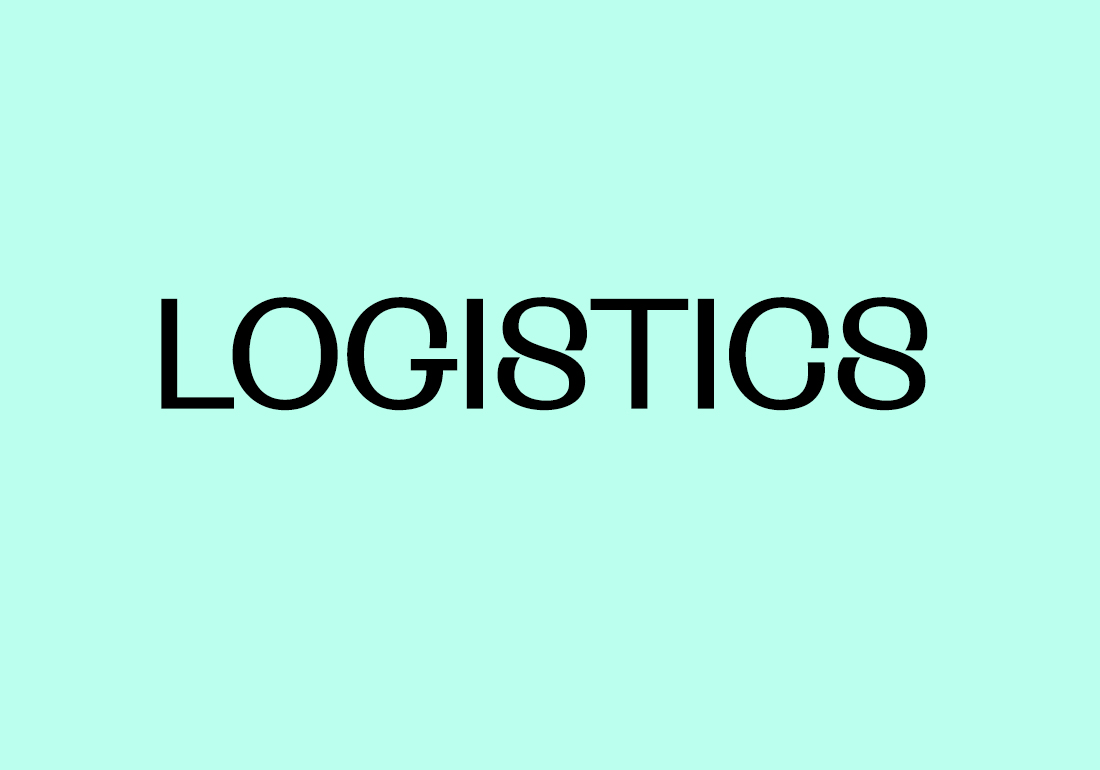Imagine you are the owner of a factory. You have optimized your production process as much as you could, reaching the point at which you cannot extract any more profit. You are glancing over the shoulders of overpoliced workers, trying to find an answer somewhere on the production line. The answer though, lies outside of the factory—you should weaponize the outside space in order to make it an extension of the factory. You can turn the area that lies between production and consumption into a source of extraction that could be optimised. In other words, you can extend the factory production line with a supply chain, creating a phenomena that in 2009 was named “supply chain capitalism” by Anna Tsing—a system in which outsourcing becomes the heart of the production process, with even wars and torture becoming outsourced.
This change in the exploitative mindset was labeled “logistical revolution” and solved the issue of capital reaching its own glass ceiling. Basically, this is how “just-in-time production” started—rendering the spaces between outsourcing facilities into a part of the production process. Charmaine Chua uses a very telling anecdote to explain the mindset of contemporary regimes of exploitation: “It is now cheaper to ship freshly caught fish from the West Coast of the United States to China to be deboned and filleted by Chinese workers and then shipped back again than it is to pay for the cost of that work under U.S. labour regulations.” Since then, logistics as an industry has grown extensively, becoming a new place for a “political and class conflict,” as Alberto Toscano puts it, that comes along with, or even replaces, the factory. Logistics today is “the new black” of the military-industrial complex—taking the form of the police, Amazon, or proxy soldiers.
Logistical revolution was not an event, despite its name, but a complex transformation with multiple histories, ranging from the spread of the use of containers during the colonial war in Vietnam, to the developments in cybernetics that allowed new calculations of the geographies of the distribution of goods. To some extent, it is possible to say that the war in Vietnam in the 70s provided a kind of a “hardware”—standardized boxes that brought closer the fantasy of seamless flow that would facilitate the colonial expansion of capital. Cybernetics after the second world war were a “software,” that when merged with logistics in the 60s, allowed the scheduling of new “geographies of calculation”—plan distribution/outsourcing on a qualitatively new level.
Logistics is, initially, a military art. It was born, according to Deborah Cowen, to solve the problem of fueling the battlefield. For a long time it has been in the background of military actions, considered as inherently secondary towards them, but responsible for making them possible in the first place. Later, logistics was adopted and brought to the forefront of seemingly civilian capitalist production. The division between civilian and military logistics should be operated quite carefully, though, as it is not legitimate in a majority of cases. There are not only military goods and people being transported by private companies, and in most cases through civilian infrastructures with other “normal” goods on board, but also vice-versa—“many of WalMart’s managers and executives—who set the standard for the industry as a whole—come from the military,” according to Jasper Bernes. It creates conditions in which the blurred line between these two categories becomes the smokescreen for warfare, making it harder to distinguish from seemingly non-militarized flows of capital.
Logistics, taken as a method of research, allows us to outline the materiality of connections, introducing the third dimension to the two-dimensional line that goes from the point of dispatch to the delivery address in tracking apps. One could think of logistics as a way to blueprint hollows, like the one that was left in place of a logistical worker in a monument dedicated to food delivery staff working during the Covid-19 lockdown in Moscow. We should strive to locate these hollows and see the nodes that connect those negative spaces, not only spatially but also temporally. We should see historical processes logistically, reconnecting the orphans of Russian logistical history that seem to have appeared out of thin air with their origins in the Soviet invasion of Afghanistan.
Further reading IN ENGLISH
Alimahomed-Wilson, Jake, and Potiker, Spencer Louis. “The Logistics of Occupation: Israel’s Colonial Suppression of Palestine’s Goods Movement Infrastructure: The Logistics of Occupation.” Journal of Labor and Society 20, no. 4 (December 2017): 427–47.
Bernes, Jasper. “Logistics, Counterlogistics and the Communist Prospect.” Endnotes, no. 3 (September 2013).
Bologna, Sergio. “Inside Logistics: Organization, Work, Distinctions.” Viewpoint Magazine (October 29, 2014).
Chua, Charmaine. “Indurable Monstrosities.” FutureLand: Stories from the Global Supply Chain (2018): 140-162.
Cowen, Deborah. The Deadly Life of Logistics: Mapping Violence in Global Trade. Minneapolis; London: University of Minnesota Press, 2014.
Denman, Derek S. “The Logistics of Police Power: Armored Vehicles, Colonial Boomerangs, and Strategies of Circulation.” Environment and Planning D: Society and Space, (June 2020).
Distributed Cognition Cooperative. “Intermodal Terminal,” 2020.
eeefff (Spesivtsev, Nicolay, and Zhuk, Dzina ). “Artificial Intelligence and Political Participation in the Smart City.”
Engelhardt, Anna. “Adversarial Infrastructure: The Crimean Bridge.” Mute Magazine, (July 7th, 2020).
Martin, Craig. “Desperate Mobilities: Logistics, Security and the Extra-Logistical Knowledge of ‘Appropriation.’” Geopolitics, (2012): 17:2, 355-376.
Mezzadra, Sandro, and Neilson, Brett. “Between Inclusion and Exclusion: On the Topology of Global Space and Borders.” Theory, Culture & Society. 29 (2012): 58-75.
Miller, Johnny. “Roads to Nowhere: How Infrastructure Built on American Inequality.” Guardian, quoted in Lambert, Lambert. “Introduction.” Funambulist, no. 17 (May - June 2018).
Neilson, Brett. “Five Theses on Understanding Logistics as Power.” Distinktion: Journal of Social Theory 13, no. 3 (December 2012): 322–39. https://doi.org/10.1080/1600910X.2012.728533.
Neilson, Brett. “Follow the Software: Reflections on the Logistical Worlds Project.” In: Neilson B., Rossiter N., Samaddar R. (eds) Logistical Asia. Palgrave Macmillan, Singapore, 2018.
Rossiter, Ned, “The Logistical City: Software, Infrastructure, Labor.” Transit Labour 4 (2012): 25–7.
Salter, Mark B. “To Make Move and Let Stop: Mobility and the Assemblage of Circulation.” Mobilities 8, no. 1 (February 2013): 7–19.
Scotto, Giulia. “Colonial and Postcolonial Logistics.” Footprint, (November 2018).
Sigler, Thomas J. “Panama as Palimpsest: The Reformulation of the ‘Transit Corridor’ in a Global Economy.” Int J Urban Reg Res, 38 (2014): 886-902.
Szerszynski, Bronislaw. “Planetary Mobilities: Movement, Memory and Emergence in the Body of the Earth.” Mobilities, 11:4 (2016): 614-628.
Toscano, Alberto. “Logistics and Opposition.” Mute, 10 (2011).
Toscano, Alberto. “Lineaments of the Logistical State.” Viewpoint, no. 4 (2014).
Tsing, Anna (2009) “Supply Chains and the Human Condition.” Rethinking Marxism: A Journal of Economics, Culture & Society, 21:2, 148-176.
FURTHER READING IN RUSSIAN
Алексеева О. «В Уклоне все лентяи, а Убер — это шарашкина контора»: как таксистов заставляют любить свою работу // Спiльне. — 30 июля 2018.
Гетманова Д. Логистический семинар 20.12.2019 / Д. Гетманова, С. Шестакова, А. Щербина, А. Энгельхардт // YouTube.
Группировка eeefff. Машины против машин // Разногласия. — 2016. — № 9.
Группировка eeefff. Автоматическая рекреационная зона // Eeefff.org.
Группировка eeefff. Публикация от 2 октября 2019 // Facebook.
Группировка eeefff. Публикация от 30 сентября 2019 // Facebook.
Группировка eeefff. Публикация от 28 сентября 2019 // Facebook.
Группировка eeefff. Публикация от 27 сентября 2019 // Facebook.
Группировка eeefff. Публикация от 29 сентября 2019 // Facebook.
Кооператив Распределенного Сознания // Интермодальный терминал. — 2019.
Кооператив Распределенного Сознания. Большие краны дают нам большие преимущества // Сигма. — 17 декабря 2019.
Панкратова И. Настоящая история Wildberries. Как Татьяна Бакальчук стала царицей e-commerce и кто ей в этом помог // The Bell. — 27 августа 2020.
Симоянов А. Сервисный пролетариат: может ли движение курьеров положить конец модели «работающей бедности»? // Рабкор. — 27 июля 2020.
Синятуллина Л. Оценка эффектов от внедрения цифровых платформ на рынке такси / Л. Синятуллина, А. Жулин // НИУ ВШЭ. — 26 февраля 2020.
Шенталь А. Критика логистического разума // Teletype. — 19 февраля 2020.
Растегаева М. Когда, вы говорите, отменили рабство? : интервью с создательницами активистского комикса «Я.Еда» // Эгалите. — апрель 2020. — С. 18–24.
Энгельхардт А. Состязательная инфраструктура. — 2020.
Я.Еда. Публикация от 2 ноября 2020 // Facebook.







